R.J. Stowell's Blog: rjsomeone, page 78
April 17, 2018
Fuckin' A, Paul Simon - Rock 'n' Roll Literary Devices
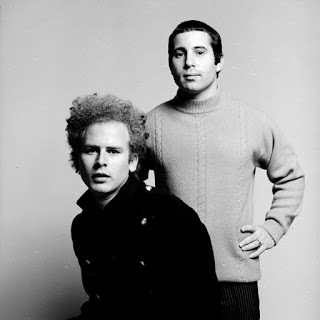 No other way to describe it. AM has defined the literary genius of Dylan and Leonard Cohen and ashamedly glossed over Paul Simon. Sincerest apologies. Simon and Garfunkel's "I am a Rock" kicks off with three consecutive splashes of alliteration, the use of consecutive initial consonants. These repetitions establish a gloomy setting in "a deep and dark December" and "on a freshly fallen silent shroud of snow," conjuring up a sense of imagery not unlike Phantasmagoria, 19th Century theatrical trickery using a "magic lantern" to cast frightening images of ghosts and skeletons. The lines serve to spice up what would be an otherwise boring stanza; there's not a lot of action going on here in that the function is to simply lay the scene. Amplification is also utilized when our narrator says "I've built walls," then goes on to continue the idea, comparing those walls to "a fortress deep and mighty." Metonymy, substituting a common phrase to sum up a scenario (i.e. calling the whole of government "The White House") is used when the poet references his hardened resolve as "armor." Fuckin' A, Paul Simon.
No other way to describe it. AM has defined the literary genius of Dylan and Leonard Cohen and ashamedly glossed over Paul Simon. Sincerest apologies. Simon and Garfunkel's "I am a Rock" kicks off with three consecutive splashes of alliteration, the use of consecutive initial consonants. These repetitions establish a gloomy setting in "a deep and dark December" and "on a freshly fallen silent shroud of snow," conjuring up a sense of imagery not unlike Phantasmagoria, 19th Century theatrical trickery using a "magic lantern" to cast frightening images of ghosts and skeletons. The lines serve to spice up what would be an otherwise boring stanza; there's not a lot of action going on here in that the function is to simply lay the scene. Amplification is also utilized when our narrator says "I've built walls," then goes on to continue the idea, comparing those walls to "a fortress deep and mighty." Metonymy, substituting a common phrase to sum up a scenario (i.e. calling the whole of government "The White House") is used when the poet references his hardened resolve as "armor." Fuckin' A, Paul Simon. 
 The epitome of creative analogies is the transferred epithet, which uses an entirely unrelated word not typically used to describe an idea or concept. For instance, Simon uses the word "shroud" to describe snow, which is odd because a shroud is a piece of clothing, and usually wouldn't describe weather-related phenomena. The same can be said about "hiding in my room, safe within my womb." If the analogy is taken literally, the protagonist has found an actual womb to seclude himself within; the listener, however, is clever enough to know that Simon uses the protective nature of a mother's womb and transfers that idea to his secluded room.
The epitome of creative analogies is the transferred epithet, which uses an entirely unrelated word not typically used to describe an idea or concept. For instance, Simon uses the word "shroud" to describe snow, which is odd because a shroud is a piece of clothing, and usually wouldn't describe weather-related phenomena. The same can be said about "hiding in my room, safe within my womb." If the analogy is taken literally, the protagonist has found an actual womb to seclude himself within; the listener, however, is clever enough to know that Simon uses the protective nature of a mother's womb and transfers that idea to his secluded room. Procatalepsis is when the speaker anticipates an objection from some unknown person and responds to it. The narrator suddenly exclaims, "Don’t talk of love." The listener doesn't know who he's talking to, though the song seems an intimate conversation focused on the trials and hard-learned lessons of a nasty love affair, or simply the stressors of life.
And if there's a sure way to convince oneself of anything, it's through repetition. Constantly Simon restates that he is a rock and an island, and always at the end of his stanzas. This literary device is known as epistrophe, where words are repeated at the end of phrases, not unlike the refrain. "I am a rock, I am an island" is also an example of the song's most prominent metaphors. Indeed, the song is dripping with them. In fact, the entire poem is an extended metaphor ornamented with smaller metaphors, like stacking Russian dolls (sorry, that's a simile). Personification, too, runs rampant. Love does not literally sleep, feelings cannot slumber, nor can they die. If books and poetry had actual protective qualities, I'm sure they would be more intimate in the lives of today's youth, and no one would Pokehunting. The concluding couplet states that rocks and islands don't feel pain nor do they cry. Here, Simon attributes human capabilities to inanimate objects. We are to assume that the rock cannot feel pain, but it can experience other emotions and sensations. The island doesn't cry, but is capable of other emotions. That's as complex as personification gets. Fuckin' A, Paul Simon.
Published on April 17, 2018 05:48
April 16, 2018
Time It Was and What a Time It Was, It Was
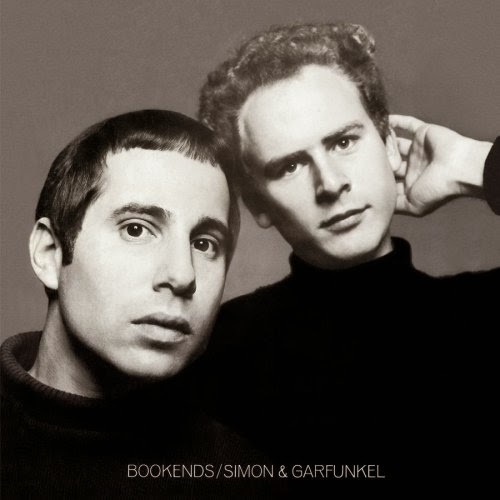 Cover by Richard AvedonBookends (AM9)Artist: Simon and GarfunkelProduced by: Simon and Garfunkel, Roy HaleeReleased: April 3, 1968Length: 29:51Tracks: 1) Bookends Theme (:32); 2) Save the Life of My Child (2:49); 3) America (3:34) 4) Overs (2:14); 5) Voices of Old People (2:07); 6) Bookends Theme (1:16) 7) Fakin' It (3:14); 8) Punky's Dilemma (2:10); 9) Mrs. Robinson (4:02); 10) A Hazy Shade of Winter (2:17); 11) At the Zoo (2:21)Players: Paul Simon - vocals, guitar; Art Garfunkel - vocals, guitar; Hal Blaine - drums, percussion; Joe Osborn - bass; Larry Knecktel - piano, synths
Cover by Richard AvedonBookends (AM9)Artist: Simon and GarfunkelProduced by: Simon and Garfunkel, Roy HaleeReleased: April 3, 1968Length: 29:51Tracks: 1) Bookends Theme (:32); 2) Save the Life of My Child (2:49); 3) America (3:34) 4) Overs (2:14); 5) Voices of Old People (2:07); 6) Bookends Theme (1:16) 7) Fakin' It (3:14); 8) Punky's Dilemma (2:10); 9) Mrs. Robinson (4:02); 10) A Hazy Shade of Winter (2:17); 11) At the Zoo (2:21)Players: Paul Simon - vocals, guitar; Art Garfunkel - vocals, guitar; Hal Blaine - drums, percussion; Joe Osborn - bass; Larry Knecktel - piano, synths Ultimately, and through no fault of its own, Bookends suffers from the fame of half its songs. Tracks like "Mrs. Robinson," "A Hazy Shade of Winter," "America," and "At the Zoo" are so well known that it's hard to view the album as a whole. To the casual listener, the song snippets, experiments and overdubs, so essential to the theme, come across as irritating interludes between hits. While the duo's previous LP (1966's Parsley, Sage, Rosemary & Thyme) showcased both Simon's lyricism and Garfunkel's elegiac vocals, Bookends transcends its predecessor in terms of its subtle ambition. Traditional production values and classic song structure are disavowed by Simon's lithe songwriting and Garfunkel's atypical vocal arrangements. Each of the duo's customary roles are intertwined, leaving Bookends their most diplomatic work; most notably Simon's zeugmatic lyrical stream on "Save the Life of My Child" and Garfunkel's beautiful interlude on "Overs;" (arguably the critics' least favorite tracks).
The beauty of the album is overpowering. "America," like The Beach Boys' "God Only Knows" and The Beatles' "The Long and Winding Road" is breathtaking. In Steven Holden's 1972 New York Times review he said: “It is three and a half minutes of sheer brilliance, whose unforced narrative, alternating precise detail with sweeping observation, evokes the panorama of restless, paved America and simultaneously illuminates a drama of shared loneliness on a bus trip with cosmic implications." Yeah, yeah, in simpler terms, it's beautiful; as is "Old Friends," but there instead is the perpetual sadness haunting our mortality.
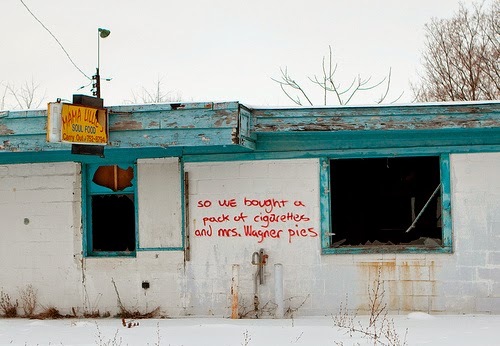 One of many Saginaw buildings with "America" graffiti.Themes of age and aging pervade the record with tracks calling into question many sacrosanct inter-generational ideals, yet failing to provide any answers. Like life, Bookends can be frustrating, yet it is those tracks that most readily take this ambiguous stance, which are the most beloved in Simon and Garfunkel's canon (the hits listed above plus “Old Friends/Bookends). For much of its overt seriousness and underlying caveat, however, there is still an infectious sense of exuberance to Bookends ("Fakin' It" and "Punky's Dilemma"), and it takes a heart of stone not to reminisce "At the Zoo." Simon and Garfunkel are folk music's most acclaimed duo and as such the albums before and after Bookends are often perceived as their finest. In AM terms, Bookends is the top dog, an album that transcends the folk hashtag; only the brevity of the album and experimentation that doesn't quite work keep the album from being an AM10.
One of many Saginaw buildings with "America" graffiti.Themes of age and aging pervade the record with tracks calling into question many sacrosanct inter-generational ideals, yet failing to provide any answers. Like life, Bookends can be frustrating, yet it is those tracks that most readily take this ambiguous stance, which are the most beloved in Simon and Garfunkel's canon (the hits listed above plus “Old Friends/Bookends). For much of its overt seriousness and underlying caveat, however, there is still an infectious sense of exuberance to Bookends ("Fakin' It" and "Punky's Dilemma"), and it takes a heart of stone not to reminisce "At the Zoo." Simon and Garfunkel are folk music's most acclaimed duo and as such the albums before and after Bookends are often perceived as their finest. In AM terms, Bookends is the top dog, an album that transcends the folk hashtag; only the brevity of the album and experimentation that doesn't quite work keep the album from being an AM10.
Published on April 16, 2018 04:39
Sounds of Silence
 Gaia would play it over and over, maybe not because she liked it that much, but it was one of just a handful of LPs she had. See, there was this stereo/mono thing. If you played a stereo LP on a mono player, the stereo version was forever downgraded to monaural. To this day I don't know if it’s true. Doesn't seem likely. I don't want to look it up; some of life has to be a mystery.
Gaia would play it over and over, maybe not because she liked it that much, but it was one of just a handful of LPs she had. See, there was this stereo/mono thing. If you played a stereo LP on a mono player, the stereo version was forever downgraded to monaural. To this day I don't know if it’s true. Doesn't seem likely. I don't want to look it up; some of life has to be a mystery.
So she could only play certain LPs in her room and she'd play Sounds of Silence all the time. The only other albums I can remember in her room were Richard Harris with "MacArthur’s Park" and Grateful Dead. So Sounds of Silence was one of those LPs that I know every part of, every little nuance. Once, on a Saturday, my mother and Carl were away and I was sleeping over in the guest room, but we put on our pajamas and got to listen to music. I was 12 and her flannel PJs made be uncomfortable and Gaia, said “Do you think I’m pretty?” I did. I didn’t answer and, embarrassed, looked away. The song was "April, Come She Will."
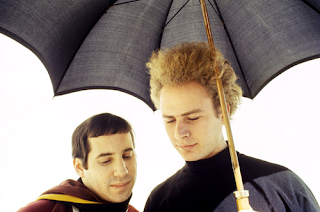 Drawing mostly on material from an album Paul Simon recorded during his time in England, The Paul Simon Songbook, there is little on Sounds of Silence (AM6+) that hadn't appeared in some form previously with only "Blessed" and "Richard Cory" completely new material. "The Sound of Silence" is the same track as on Wednesday Morning 3.A.M.but with the inspired addition of electric guitars that make the song even more powerful, with Simon's and Garfunkel's voices now blended together amidst a hypnotic drumbeat and bass line; the original acoustic guitar aided by the melancholic jangle of the electric. The lyrics ring out clear and true, and they are among the most celebrated and highly regarded of Paul Simon's efforts, with the famous "The words of the prophets/Are written on the subway walls" being the peak of his poetic output.
Drawing mostly on material from an album Paul Simon recorded during his time in England, The Paul Simon Songbook, there is little on Sounds of Silence (AM6+) that hadn't appeared in some form previously with only "Blessed" and "Richard Cory" completely new material. "The Sound of Silence" is the same track as on Wednesday Morning 3.A.M.but with the inspired addition of electric guitars that make the song even more powerful, with Simon's and Garfunkel's voices now blended together amidst a hypnotic drumbeat and bass line; the original acoustic guitar aided by the melancholic jangle of the electric. The lyrics ring out clear and true, and they are among the most celebrated and highly regarded of Paul Simon's efforts, with the famous "The words of the prophets/Are written on the subway walls" being the peak of his poetic output. "The Sound of Silence" is the most well-known, and best, track here, a haunting stream of words tied to one eerie little riff, but it’s followed closely by the equally peerless "I Am a Rock:" ("I am a rock/ I am an island/ And a rock feels no pain/ And an island never cries.") the two tracks acting as bookends to the album, none of it as inspired, but all in place, all the perfect listen late at night (in our case 9:00pm); quite, simple folk, like folk's Abbey Road. (While the bookends are pure misanthropic pop, "Richard Cory" and "A Most Peculiar Man" are intriguing as back to back tracks, two consecutive songs about men who commit suicide.) Sounds of Silence is a testament to the pair's combined talents, but their real magic was not yet realized.
Published on April 16, 2018 04:38
April 14, 2018
Freak Out in a Moonage Daydream
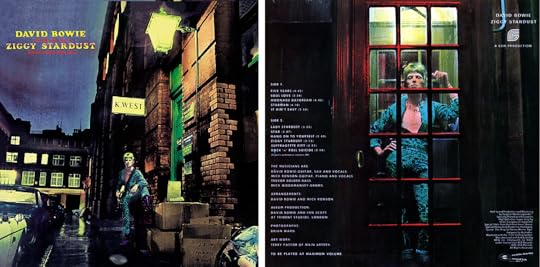 TO BE PLAYED AT MAXIMUM VOLUMEIn 1971, David Bowie was an avid admirer of the cast of Andy Warhol's Pork. Enamored with the film and its cast, Bowie couldn't get enough of Warhol's entourage, indeed several crew and cast members ended up at Mainman working as office assistants and Bowie flunkies; it was mutual admiration. There was something extraordinary about the Warhol scene, the exploits of big-city artists and junkies and queens; Ziggy was fascinated. London was a distant, morose place in the early 70s, having lost that glam spark of Mary Quant and The Fool, not to mention the Stones and a sense of identity to America; New York and Warhol were new, exciting and mysterious. Post-industrial London was a symptom of the age and Ziggy Stardust was its cure.
TO BE PLAYED AT MAXIMUM VOLUMEIn 1971, David Bowie was an avid admirer of the cast of Andy Warhol's Pork. Enamored with the film and its cast, Bowie couldn't get enough of Warhol's entourage, indeed several crew and cast members ended up at Mainman working as office assistants and Bowie flunkies; it was mutual admiration. There was something extraordinary about the Warhol scene, the exploits of big-city artists and junkies and queens; Ziggy was fascinated. London was a distant, morose place in the early 70s, having lost that glam spark of Mary Quant and The Fool, not to mention the Stones and a sense of identity to America; New York and Warhol were new, exciting and mysterious. Post-industrial London was a symptom of the age and Ziggy Stardust was its cure.The Rise and Fall of Ziggy Stardust and the Spiders from Mars (AM10) takes the musicianship and experimental bent of Bowie's Hunky Dory to a new level, on which Bowie forges a distinctive sound that prevails despite every new incarnation. Although a concept, Ziggy never seems forced or repetitive; it is but a grand parade of songs which collectively tell a story. The lyrics are deep and emotive, albeit tragic; the musicianship fuzzy and warm or brash and abrasive.
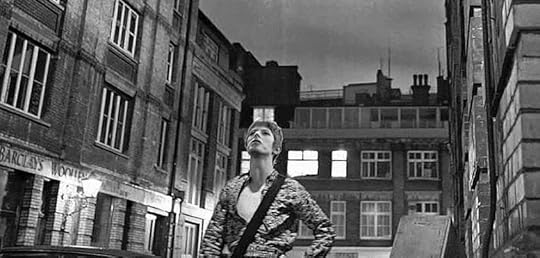 An off-beat drum pattern by Mick Woodmansey fuels the opening song "Five Years." Moody and low key with a definite influence from the Plastic Ono Band, the character of Ziggy Stardust is introduced in dramatic yet elegant fashion with profound lyrics, such as;
An off-beat drum pattern by Mick Woodmansey fuels the opening song "Five Years." Moody and low key with a definite influence from the Plastic Ono Band, the character of Ziggy Stardust is introduced in dramatic yet elegant fashion with profound lyrics, such as;"my brain hurt like a warehouse, it had no room to spare/ I had to cram many things to store everything in there…"
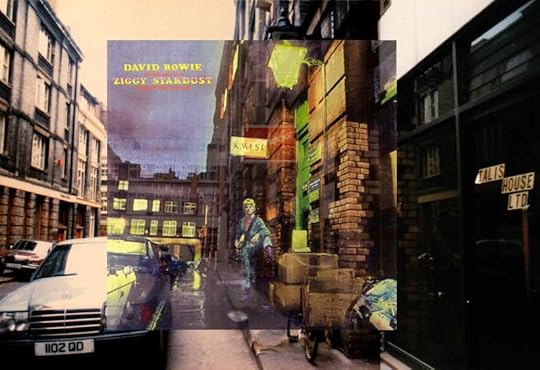
"Starman" is classic Bowie hearkening back to the same groove thematically as his first major hit "Space Oddity." An acoustic ballad accentuated by space-age transitional effects, orchestration, and great post-chorus riff by Mick Ronson, the song is that pivotal point in the album's concept where the protagonist morphs from being manipulative to delusional.
The moody piano of "Lady Stardust" starts off side two with a ballad of nearly Taupin/John proportion and structure. There is little to no guitar presence on this tune loosely dedicated to Marc Bolan of T. Rex and the "glam" scene in general. "Hang On to Yourself" comes off like early proto-punk with a definite glam twist. "Suffragette City" reminds the listener that David Bowie is, in fact, a rock star first and foremost, no matter how out there the bulk of his material may drift. The song was originally offered to Mott the Hoople before they chose "All the Young Dudes" for their own project.
After the frantic, top-notch electric rock of "Suffragette City," the album closes with the calm and acoustic "Rock 'n' Roll Suicide," which documents Ziggy's collapse as a washed-up performer (showing an amazing sense of self-awareness at a time when rock was still relatively young). The song gradually builds through subtle, tremolo electric guitar effects and into full orchestration as a dramatic coda for the album.
Ziggy catapulted Bowie into the big time, and rightly so - it is a fascinating concept executed to an endearingly accomplished standard. Quite simply, The Rise And Fall Of Ziggy Stardust And The Spiders From Mars is one of the most important and essential rock albums ever made. And because it's Bowie of course, it rises above the genre as well and becomes an essential piece of science fiction as well, not of a dystopian society, but of a real world, a dysfunctional London unraveling at its seams.
Published on April 14, 2018 04:52
Ziggy Stardust - Another Shameless Plug for Jay and the Americans
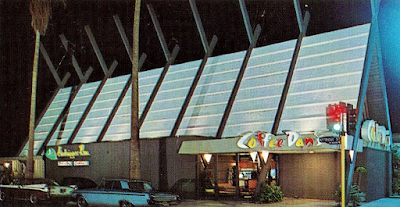 Max Ten had the house to himself; his parents, God knows where. "Paige was here, but she's gone out. Bring Gaia," but Gaia didn't answer, and I walked down Van Nuys Blvd. on a cool day in June. It was cruise night. I saw Driggers in his Super Bee with Laurie Heiser, so freakin' hot. They stopped by Coffee Dan's. I couldn't keep my eyes off her. "Come cruise with us, Jay. We're going to June Ellen's for donuts and then up to Mulholland."
Max Ten had the house to himself; his parents, God knows where. "Paige was here, but she's gone out. Bring Gaia," but Gaia didn't answer, and I walked down Van Nuys Blvd. on a cool day in June. It was cruise night. I saw Driggers in his Super Bee with Laurie Heiser, so freakin' hot. They stopped by Coffee Dan's. I couldn't keep my eyes off her. "Come cruise with us, Jay. We're going to June Ellen's for donuts and then up to Mulholland.""Can I make out with Heiser?" I looked at her. "Someday," I said and looked her in the eye with a grin.
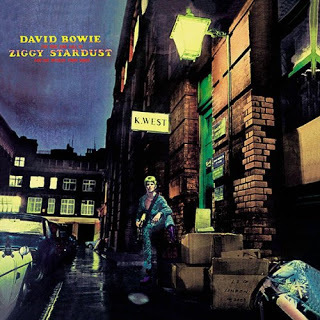 "K. I'll let Gaia know."
"K. I'll let Gaia know."He put the roof down and soared down Sylvan like a rocket. I crossed the street into Crane's Records by the Crocker Citizen Bank. In the window was Blue and Alice Cooper's School's Out. Honky Chateau was playing in the background. But I was after Ziggy. Max and I had gone mad over "Space Oddity," and I read in Creem about Ziggy. Bowie is an alien who manifests himself as a rock star to bring hope to a world that has just five years left. Max and I had read Clockwork and 1984 and We and Ziggy’s dystopian theme fit right in.
When Max Ten's parents were away last week, when he threw the big themed Mexican bash and we all dropped acid, we'd played like adults, using the good stereo in the living room, eating off the Fiesta Ware on the white sofa, but they'd be back in the morning and he'd cleaned and vacuumed and when I got there, they were in the garage. The garage was the kid's lair. His parents would throw parties and zip through cases of champagne and all the kids would be in the garage smoking pot. Paigeboy was an artist and she'd painted album covers on the doors of each of the cabinets. She'd painted Every Good Boy Deserves Favor and Teaser and the Firecat and Foxtrot. Sheets was there playing air drums; never missed a beat. Donna Miller was there, legs right up to her chin, which explained her beard (I always liked that joke). There was a pot haze in the room and Robert A. was suckin' on a bong. "Look." I pulled Ziggy out of the bag.
"Oh, man! We gotta get high first."
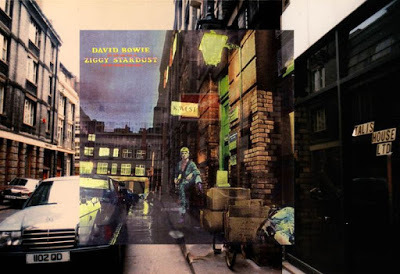 "Look, it says, 'TO BE PLAYED AT MAXIMUM VOLUME.'" Max was going through a lid of Colombian and then he reached into his pocket and said, "I forgot about this. Thai Stick." He took the bong from Robert A. and packed the Thai into it. It was the kind of high that you wanted to rip off your clothes and run down the street and yell, "I'm free," like Tommy (and freedom tastes of reality).
"Look, it says, 'TO BE PLAYED AT MAXIMUM VOLUME.'" Max was going through a lid of Colombian and then he reached into his pocket and said, "I forgot about this. Thai Stick." He took the bong from Robert A. and packed the Thai into it. It was the kind of high that you wanted to rip off your clothes and run down the street and yell, "I'm free," like Tommy (and freedom tastes of reality).And oh, fuckin' A, "Five Years." The melancholy. Bowie, I mean Ziggy, yelling at us and then he screams, "So many people." I sat next to Max and Ziggy sang "I kiss you, you're beautiful, I want you to walk," and it was my imagination or his contact lenses, but Max had a rookerful of tears in his glazzies; Horrorshow, oh my brothers. "Soul Love" funked its way to "Moonage Daydream" without pause. "I'm a space invader," and then it was all Mick Ronson and so beautiful, and "Starman" too, and it felt a bit sad until those hopeful la la la's that make you want to smile.
"I wish Gaia could hear this."
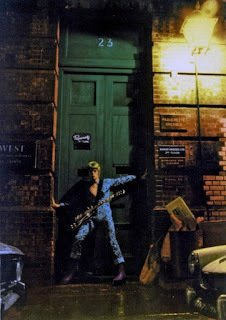 "It Ain't Easy" was instantly recognizable with more of a classic rock 1960s feel to it, as if you'd known it all your life.
"It Ain't Easy" was instantly recognizable with more of a classic rock 1960s feel to it, as if you'd known it all your life. "It's The Kinks, man."
"Lady Stardust," had a little bit of an Elton John feel to it. I called Gaia again. She answered. "I want you to hear this with me." I put her on speaker phone.
"That's so pretty," she said. Then, "My mom said I gotta go." I was so high I hardly heard her, and I spaced out and I was far away and I came to and it was quiet and Ziggy crooned about time and a cigarette and it built up and Chev brakes were snarling and you stumbled across the road. You're a rock 'n' roll suicide. And Ziggy cried out, "Gimme your hands, gimme your hands, cause you're wonderful."
I dialed her number. It was Gaia's mom. "Can I just talk to her for a minute?" and I made Max play it again and I said, "Listen to this."
"Okay, Jay. I have to go."
She got off the phone and I sang, "Cause you’re wonderful" and Max repeated it. "Wonderful," he sang.
Jay and the Americans is available all over the world!
Like these snippets? Get the novel now!
CreateSpace - Amazon - Amazon UK - Amazon France - Amazon Russia
Published on April 14, 2018 04:52
April 13, 2018
My Story Goes... Ziggy Stardust and the Spiders From Mars
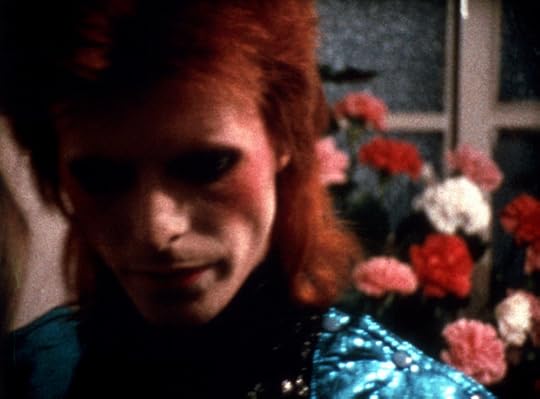 I encountered David Bowie for the first time by accident. In the U.S. in the early 70s, Bowie was an unknown. The rock scene in the states was dictated at the time by AOR radio which embraced early Springsteen and Patti Smith, The Who (but only Tommy), Elton John and Fleetwood Mac, but Bowie flew under the radar. His only radio play, with one obvious exception, would come in the off-hours (I remember a live broadcast of the Santa Monica Civic concert on The King Biscuit Flower Hour in 1972). The exception, of course, was the limited radio play of "Space Oddity," a 1969 U.K. release from the eponymously titled LP that wasn't released in the States until 1972 (with the new title Space Oddity). I was the only misfit in my school to embrace the single but didn’t know the song's name.
I encountered David Bowie for the first time by accident. In the U.S. in the early 70s, Bowie was an unknown. The rock scene in the states was dictated at the time by AOR radio which embraced early Springsteen and Patti Smith, The Who (but only Tommy), Elton John and Fleetwood Mac, but Bowie flew under the radar. His only radio play, with one obvious exception, would come in the off-hours (I remember a live broadcast of the Santa Monica Civic concert on The King Biscuit Flower Hour in 1972). The exception, of course, was the limited radio play of "Space Oddity," a 1969 U.K. release from the eponymously titled LP that wasn't released in the States until 1972 (with the new title Space Oddity). I was the only misfit in my school to embrace the single but didn’t know the song's name. I ventured out with allowance monies to the Licorice Pizza and mistakenly bought The Man Who Sold the World, Bowie’s heaviest and loudest effort until Tin Men. While it wasn't my bent, the brash and wonderful "Width of a Circle" was too much for my 10-year old sensibilities (not to mention the frightening "She Shook Me Cold"), I was intrigued by the funky beat of "Black Country Rock" and especially embraced "All the Madmen" and listened to it all day long.
I ventured out with allowance monies to the Licorice Pizza and mistakenly bought The Man Who Sold the World, Bowie’s heaviest and loudest effort until Tin Men. While it wasn't my bent, the brash and wonderful "Width of a Circle" was too much for my 10-year old sensibilities (not to mention the frightening "She Shook Me Cold"), I was intrigued by the funky beat of "Black Country Rock" and especially embraced "All the Madmen" and listened to it all day long. Still, I'd spent my hard-earned money (washing dishes) and didn't get the song I wanted. On a subsequent Sunday, I recorded the track from America's Top 40 with Kasey Kasem on a kids reel to reel and a few days later my brother snagged The Man Who Sold the World and took it to one of his pot parties. I never got it back.
 My brother's trick was always to buy LPs he liked for my birthday or Christmas. Then he'd borrow them. While I could resent that little ploy, it accounted for some of the most enlightening moments in my musical rearing. Among those LPs he gave me was King Crimson's In the Court of the Crimson King (the album cover so frightening I didn't listen to it), Burt Bacharach's Reach Out and Blood Sweat and Tears. Then on my birthday in November '72, he gave me Ziggy Stardust. I was 11, and oh my God, it was a story. It was like the Twilight Zone or the Outer Limits or like Crack in the World. It was loud and it was meant to be. On the back, it said "TO BE PLAYED AT MAXIMUM VOLUME." Too young to truly appreciate Sgt. Pepper when it came out and a decade too soon for Pet Sounds, Ziggy was the first truly meaningful album that I'd ever heard. And, as the story goes, it was on that day that music became an integral part of who I was and have remained nearly 50 years later.
My brother's trick was always to buy LPs he liked for my birthday or Christmas. Then he'd borrow them. While I could resent that little ploy, it accounted for some of the most enlightening moments in my musical rearing. Among those LPs he gave me was King Crimson's In the Court of the Crimson King (the album cover so frightening I didn't listen to it), Burt Bacharach's Reach Out and Blood Sweat and Tears. Then on my birthday in November '72, he gave me Ziggy Stardust. I was 11, and oh my God, it was a story. It was like the Twilight Zone or the Outer Limits or like Crack in the World. It was loud and it was meant to be. On the back, it said "TO BE PLAYED AT MAXIMUM VOLUME." Too young to truly appreciate Sgt. Pepper when it came out and a decade too soon for Pet Sounds, Ziggy was the first truly meaningful album that I'd ever heard. And, as the story goes, it was on that day that music became an integral part of who I was and have remained nearly 50 years later.
Published on April 13, 2018 07:05
The Story Goes - Part 10 - Choose Your Own Adventure
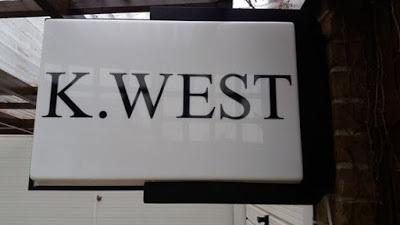 Tomorrow AM will repost the articles about the ten records every collector should have in his or her collection. The internet is a fickle thing. AM averages 1500 unique hits per day; then will come a drought. We do something and Google gets pissed, or readers do, or maybe it's just fate, and we'll go through a week with 67 guests on average with a 15 in the middle. It's all about the Google matrix, what gets posted, the time of the year.
Tomorrow AM will repost the articles about the ten records every collector should have in his or her collection. The internet is a fickle thing. AM averages 1500 unique hits per day; then will come a drought. We do something and Google gets pissed, or readers do, or maybe it's just fate, and we'll go through a week with 67 guests on average with a 15 in the middle. It's all about the Google matrix, what gets posted, the time of the year. For the ten records posts, I think we cleverly found a way to address every collector's collection, but not choosing any specific LPs, bar one, Dark Side of the Moon, but based on that damned matrix, hardly anyone read it. Now that the arc is curving back our way, we'll repost, since, you know, it really was brilliant.
Our current series didn't play the same coy game but focused on AM's choices for the ten pinnacle moments in rock's classic era (let's call it '65 through '74), just for the sake of argument, with this exception: The Story Goes... FILL IN THE BLANK. For the 10th post in this series, the concept is your most important moment. This writer's is...

The Story Goes... In the mid-60s, Bowie met British rocker Vince Taylor who recorded the 1959 classic "Brand New Cadillac," later covered by the Clash. After too much LSD and an emotional breakdown (there's a unique rock story), Taylor joined a cult and decided that he was an alien god on Earth (hmm, that part's new).
Bowie was a teenage Mod fronting his band, The Lower Third, when he bumped into Vince Taylor at La Gioconda, a club in London. Taylor was an "American" rocker who was a major star in France, but by the time Bowie met him, Taylor was a washed-up acid casualty who had fried his brain after ingesting waaaaaay too much LSD. Born in Isleworth, England in 1939, the youngest of five children, his family emigrated to New Jersey when he was seven, where Taylor grew up on a diet of Elvis Presley, Jerry Lee Lewis, and Gene Vincent. When his sister Sheila dated Joseph Barbera — one half of animation team Hannah-Barbera; that's right, Jonny Quest, Flintstones, Peter Potamus — the family moved to California.
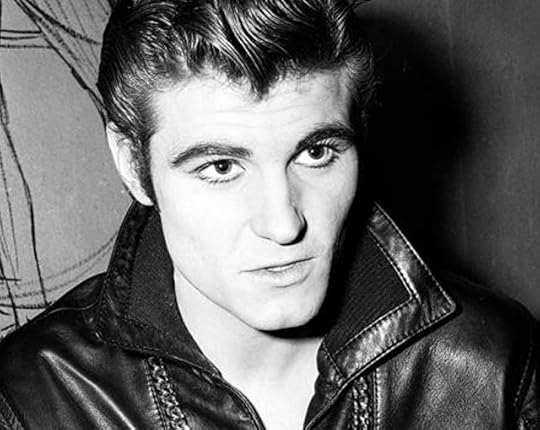 Like millions of other young American teenagers, Taylor wanted to be a rock 'n' roll idol. His singing was so-so but he could do a swell Elvis impersonation. Joe Barbera offered to manage him. When Barbera traveled to London on business—he took Taylor with him. This was when Brian Holden adopted the name "Vince Taylor." "Vince" from Elvis Presley's character "Vince Everett" in Jailhouse Rock; "Taylor" from actor Robert Taylor. After the release of his only real hit, Taylor discovered LSD. He liked it a lot. Depending on from whom you glean the info, after about a 1000 hits of acid came Taylor's Pauline conversion. He had a vision. He was not Vince Taylor but in fact, the son of Jesus Christ — Mateus Christ. After a few more tabs and a few more beatific visions — Taylor knew he was on a mission from God and set out to tell his fans who he really was.
Like millions of other young American teenagers, Taylor wanted to be a rock 'n' roll idol. His singing was so-so but he could do a swell Elvis impersonation. Joe Barbera offered to manage him. When Barbera traveled to London on business—he took Taylor with him. This was when Brian Holden adopted the name "Vince Taylor." "Vince" from Elvis Presley's character "Vince Everett" in Jailhouse Rock; "Taylor" from actor Robert Taylor. After the release of his only real hit, Taylor discovered LSD. He liked it a lot. Depending on from whom you glean the info, after about a 1000 hits of acid came Taylor's Pauline conversion. He had a vision. He was not Vince Taylor but in fact, the son of Jesus Christ — Mateus Christ. After a few more tabs and a few more beatific visions — Taylor knew he was on a mission from God and set out to tell his fans who he really was.A few nights later, Taylor said to his band (dialogue added by the writer): "All you ever think about is money. God is what you should be thinking about. I am the son of God's son. I am the new Messiah. Money is nothing. This is what I think of money." Taylor took a wad of cash out of pocket, pulled out a lighter and burned the money in front of his hungry, penniless band. It was Taylor's version of kicking the moneylenders out of the temple.
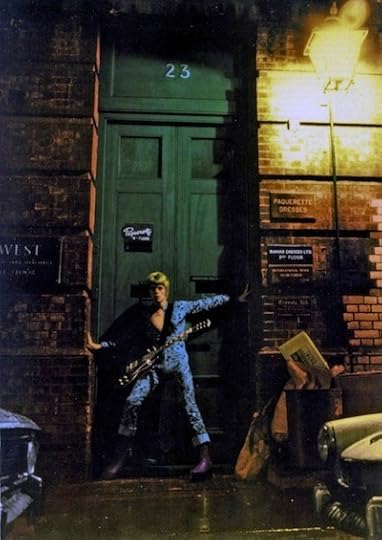 The next night, Taylor had a major gig. He turned up clean-shaven, done-up in makeup, black leathers, and a bike chain. The place was rocking. Taylor was in top form. Two numbers in, Taylor announced that he was the son of Christ. "I am Mateus," he said and sauntered off the stage and into the audience. He walked among the crowd. He blessed his followers. He gave them the Word of Mateus. "Come, follow me. I am the way." His sister Sheila was there. She freaked. Taylor told her to "Be calm. I have prepared a plane for you and my disciples. Come with me and I will fly you to my Father's kingdom in Heaven. God will make it so."
The next night, Taylor had a major gig. He turned up clean-shaven, done-up in makeup, black leathers, and a bike chain. The place was rocking. Taylor was in top form. Two numbers in, Taylor announced that he was the son of Christ. "I am Mateus," he said and sauntered off the stage and into the audience. He walked among the crowd. He blessed his followers. He gave them the Word of Mateus. "Come, follow me. I am the way." His sister Sheila was there. She freaked. Taylor told her to "Be calm. I have prepared a plane for you and my disciples. Come with me and I will fly you to my Father's kingdom in Heaven. God will make it so."Fast Forward to '72: Bowie's fascination with space travel and science fiction had already surfaced in "Space Oddity" "The Wild Eyed Boy From Freecloud" and "Life on Mars?" but he would soon be drawn toward something grander in scope. "Until that time," he later said, "the attitude was 'What you see is what you get.' It seemed interesting to try to devise something different, like a musical where the artist onstage plays a part."
It was then that Bowie met Taylor outside the Tottenham Court tube station. Taylor said he wanted to share some esoteric knowledge with the up and coming singer and unfolded a map of all the alien bases on Earth. "They're here amongst us." Bowie knelt beside Taylor on the sidewalk hunched over the map. Picture it.
 The Legendary Stardust CowboyFrom there, Bowie developed a character based on Taylor, as well as on other eccentrics like Texas "psychobilly" singer Legendary Stardust Cowboy and Japanese designer Kansai Yamamoto. "He always described how he'd take bits and pieces from all over the place, put them in a melting pot and they'd come out being him," said Bowie producer Ken Scott.Bowie dubbed this new creation "Ziggy Stardust" (first name taken from a tailor's shop that he saw from a train). As he fleshed out the concept further, Ziggy became an omnisexual alien rock star, sent to Earth as a messenger. Bowie's plot, loosely, was that humanity was in its final five years of existence, and Ziggy was dispatched to deliver a message of hope: He's a wild, hedonistic figure ("well-hung and snow-white tan"), but at his core communicates peace and love; he's the ultimate rock star. In the end, he's destroyed by his own excesses, and by his fans. There is indeed gobs of Vince Taylor there, a bit of Syd Barrett and a touch of Tommy, for that matter.
The Legendary Stardust CowboyFrom there, Bowie developed a character based on Taylor, as well as on other eccentrics like Texas "psychobilly" singer Legendary Stardust Cowboy and Japanese designer Kansai Yamamoto. "He always described how he'd take bits and pieces from all over the place, put them in a melting pot and they'd come out being him," said Bowie producer Ken Scott.Bowie dubbed this new creation "Ziggy Stardust" (first name taken from a tailor's shop that he saw from a train). As he fleshed out the concept further, Ziggy became an omnisexual alien rock star, sent to Earth as a messenger. Bowie's plot, loosely, was that humanity was in its final five years of existence, and Ziggy was dispatched to deliver a message of hope: He's a wild, hedonistic figure ("well-hung and snow-white tan"), but at his core communicates peace and love; he's the ultimate rock star. In the end, he's destroyed by his own excesses, and by his fans. There is indeed gobs of Vince Taylor there, a bit of Syd Barrett and a touch of Tommy, for that matter."Ziggy is advised in a dream by the infinites to write the coming of a starman ... this amazing spaceman who will be coming down to save the Earth," Bowie explained to William S. Burroughs in a Rolling Stone interview. "Ziggy starts to believe in all this himself and thinks himself a prophet of the future starmen. He takes himself up to the incredible spiritual heights and is kept alive by his disciples. When the infinites arrive, they take bits of Ziggy to make themselves real, because in their original state they are anti-matter and cannot exist on our world. And they tear him to pieces onstage during the song 'Rock 'n' Roll Suicide.'"
And so, what is my Story Goes moment? When Bowie met Taylor? The encounter certainly ties into the series, but no. Like you, my task is to choose my own adventure, and that I will share... tomorrow. In the mean time,
Give me your hand...
Published on April 13, 2018 04:18
April 10, 2018
Story Goes... Woodstock and Altamont
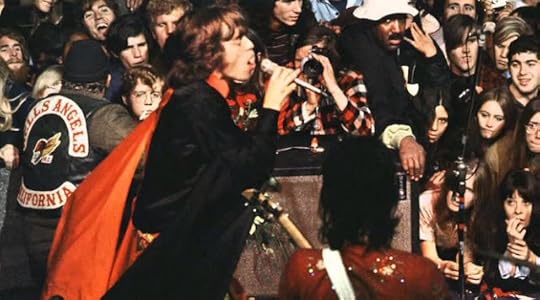 As we move toward Woodstock's 50th anniversary, AM will, of course, explore the dynamics leading up to rock's greatest outing. R.J. Stowell's Miles From Nowhere, a novel with the concert as an important backdrop, will be released later this year and AM will share snippets here and there. The Story Goes segment has covered eight of rock's most influential moments and Woodstock certainly plays a role. It may be the single most significant celebration of our music, despite the lackluster performances that pervade the three days of peace and music.
As we move toward Woodstock's 50th anniversary, AM will, of course, explore the dynamics leading up to rock's greatest outing. R.J. Stowell's Miles From Nowhere, a novel with the concert as an important backdrop, will be released later this year and AM will share snippets here and there. The Story Goes segment has covered eight of rock's most influential moments and Woodstock certainly plays a role. It may be the single most significant celebration of our music, despite the lackluster performances that pervade the three days of peace and music.But for Story Goes purposes, AM only touches on Woodstock in its juxtaposition to Altamonte. The two music festivals occurred within less than four months of each other, but they summoned wildly different images: the former, the apotheosis of the Flower Child generation; the latter, the death of the counterculture and the lost innocence of American youth.
Altamont, December 6, 1969, is remembered with infamy not only because four people died that day— people died at Woodstock, too — but because "the dream some of us had" was over. In the idyllic woods of Bethel, young people had staged their own peaceful happening. The biggest success of Woodstock was in showing that such an event could occur at all.
Hailed as "Woodstock West," Altamont would fail on every level. In explaining the volatile environment that produced one fatal stabbing, three accidental deaths, and 850 injuries, commentators have pointed to a myriad of reasons, from widespread drug use to the presence of the Hells Angels. But there were drugs (lots) and Hells Angels at Woodstock, too. Others will point to the surroundings themselves. In contrast to the green world in Bethel, New York that summer, the barren hills of Altamonte Speedway resembled something out of a dystopian novel. Spencer Dryden of the Jefferson Airplane said: "It was just a horrible, pink-sky Hieronymus Bosch dustbin, not a tree in sight, just a hellhole. It was the beginning of the end. No, not the beginning, it was the end."
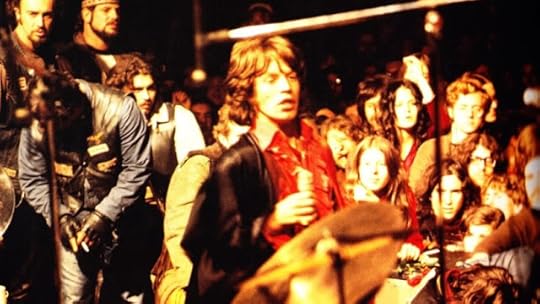
The low stage design certainly didn't help, either. Whereas the natural amphitheater and high stage at Woodstock had protected the performers from the crowd, the stage at Altamont essentially invited the crowd to get past the Hells Angels and at the performers. In contrast to the Hog Farm's "please force," the scene at Altamont was policed by the Hell’s Angels. A lot of blame goes to the MC, but in retrospect, their blame is no more valid than that of the environment, the bad planning, the poorly designed stage or the odd and ominous atmosphere. Whereas Woodstock emcee Chip Monck delivered his famously gentle warnings about bad acid making the rounds, Stones road manager Sam Cutler, when he learned of similar warnings said, "Tough shit." Maybe that sums it up.
"You need people like the Angels to keep people in line," Grace Slick said on stage — moments before Marty Balin jumped into the pit to break up a fight and was knocked out by the Angels. The Bay area Angels had in other venues occupied the place around the tech equipment or generators and established a secure location just by their presence (often in exchange for beer). These outings of trippy San Francisco bands showed that the concept could work, but while bands like Jefferson Airplane and Santana shared the stage at Altamont, this instead was a Stones concert with a distinctly different bad boy vibe. Songs like "As Tears Go By" and "Ruby Tuesday" had given way to "Street Fighting Man" and "Sympathy for the Devil."
Bottom line: Angels and hippies and Stones and booze and pills densely packed in a setting that hinted at the end of the world was an obviously combustible setting that culminated in the stabbing of a concert-goer with a gun. That statement oversimplifies the events and makes it seem as if the victim of the stabbing was the cause of melee, but it only serves to suggest that the environment at Altamont was a toxic stew that signaled the end of Flower Power and the 60s.
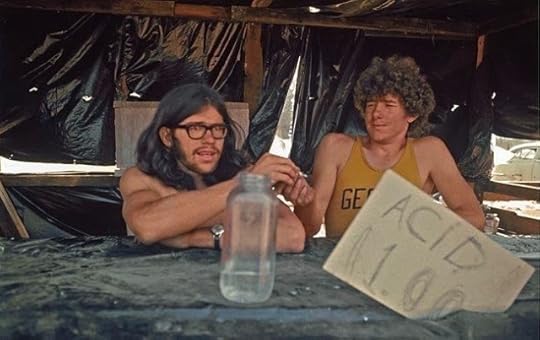
Published on April 10, 2018 05:46
April 8, 2018
Story Goes... Summer of Love and Monterey Pop
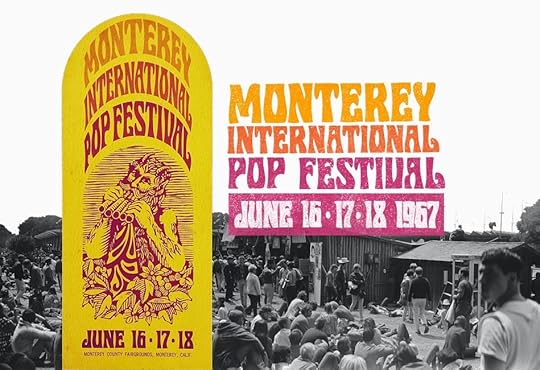 By the time we got to Woodstock... Hendrix, Janis Joplin, the Who and the Grateful Dead were demigods to the half-mil who rambled onto Yasgur's farm in the summer of '69; two years earlier, each was unknown.
By the time we got to Woodstock... Hendrix, Janis Joplin, the Who and the Grateful Dead were demigods to the half-mil who rambled onto Yasgur's farm in the summer of '69; two years earlier, each was unknown. Held over three days during the Summer of Love, the Monterey International Pop Festival (Music, Love and Flowers) featured what is now a historic lineup of performers that also included Ravi Shankar, Buffalo Springfield, The Association, Jefferson Airplane, Otis Redding, The Byrds and the Mama's and the Papa's. Monterey was a groundbreaking event, bringing together an eclectic mix of styles and sounds, and, in three days, launching the careers of a gazillion iconic players. The festival not only pioneered the idea of the multi-day rock festival, it provided the creative template that music festivals follow today, from Firefly to Coachella. Over 200,000 attended the concert organized by Papa John Phillips, who even wrote a theme song for the event, Scott McKenzie's "San Francisco (Be Sure to Wear Flowers in Your Hair)." It wasn't a corporate thing, it wasn't an Acid Test, Monterey was a legit rock event.
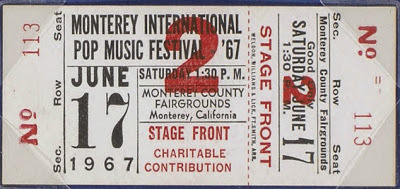 Concert Producer Lou Adler recalled the initial conversation: "It was me, John Phillips, Cass Elliot and Paul McCartney, and we were all talking about the fact that rock 'n' roll wasn't considered an art form, like jazz and the blues. John and I had both heard that in the late 30s, the series Jazz at the Philharmonic had validated jazz to people, so we thought putting rock music at the site of the already established Monterey Jazz Festival would validate rock." And validate it it did. Everything that could go right, did – from the weather (perfect, you know…California) to the music (luminescent) to the throngs of people, young and old ; it was all – the Be-ins, the Love-ins, the Acid Tests – culminating right there in Monterey. Unlike Woodstock, which would follow (without the meticulous planning), Monterey was a true festival with the feel of a Renaissance Fair or a community get together.
Concert Producer Lou Adler recalled the initial conversation: "It was me, John Phillips, Cass Elliot and Paul McCartney, and we were all talking about the fact that rock 'n' roll wasn't considered an art form, like jazz and the blues. John and I had both heard that in the late 30s, the series Jazz at the Philharmonic had validated jazz to people, so we thought putting rock music at the site of the already established Monterey Jazz Festival would validate rock." And validate it it did. Everything that could go right, did – from the weather (perfect, you know…California) to the music (luminescent) to the throngs of people, young and old ; it was all – the Be-ins, the Love-ins, the Acid Tests – culminating right there in Monterey. Unlike Woodstock, which would follow (without the meticulous planning), Monterey was a true festival with the feel of a Renaissance Fair or a community get together.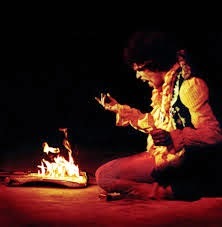 Woodstock certainly gets more press, but Monterey was where it began: Janis and "Ball and Chain," Jimi making love to, then lighting his Stratocaster on fire, Pete Townshend smashing his guitars. Indeed, Townshend originated the concept of pyrotechnic stagecraft. Close friend Hendrix quickly began mimicking the explosive routine on stage, destroying his guitars to elicit the feedback. The copycatting simultaneously delighted and infuriated Townshend. At Monterey, as Jimi smashed his gear round the stage, Cass Elliot lashed out. "Hey, destroying guitars is your thing!" she yelled to Townshend. "It used to be," he shouted back, "It belongs to Jimi now."
Woodstock certainly gets more press, but Monterey was where it began: Janis and "Ball and Chain," Jimi making love to, then lighting his Stratocaster on fire, Pete Townshend smashing his guitars. Indeed, Townshend originated the concept of pyrotechnic stagecraft. Close friend Hendrix quickly began mimicking the explosive routine on stage, destroying his guitars to elicit the feedback. The copycatting simultaneously delighted and infuriated Townshend. At Monterey, as Jimi smashed his gear round the stage, Cass Elliot lashed out. "Hey, destroying guitars is your thing!" she yelled to Townshend. "It used to be," he shouted back, "It belongs to Jimi now."  Brian Jones"No one had ever heard anything like it," said John Phillips. Grace Slick in her memoir, Somebody to Love, said, "I watched him play guitar with his teeth, use the mic stand for a slide guitar, bang into speakers for feedback, set his guitar on fire... And the fabulous outfit! He wore a perfect 60s costume: Spanish hat, Mongol vest, silk ruffled paisley shirt, pounds of handmade jewelry, and western boots. If any musician represented the era, it was Jimi Hendrix." Hendrix was introduced by The Rolling Stones' Brian Jones. It was his last public appearance. Immortalized in song by the Animals ("Monterey"), Eric Burdon sings, "His Majesty, Prince Jones/ Smiled as he moved among the crowd."
Brian Jones"No one had ever heard anything like it," said John Phillips. Grace Slick in her memoir, Somebody to Love, said, "I watched him play guitar with his teeth, use the mic stand for a slide guitar, bang into speakers for feedback, set his guitar on fire... And the fabulous outfit! He wore a perfect 60s costume: Spanish hat, Mongol vest, silk ruffled paisley shirt, pounds of handmade jewelry, and western boots. If any musician represented the era, it was Jimi Hendrix." Hendrix was introduced by The Rolling Stones' Brian Jones. It was his last public appearance. Immortalized in song by the Animals ("Monterey"), Eric Burdon sings, "His Majesty, Prince Jones/ Smiled as he moved among the crowd."
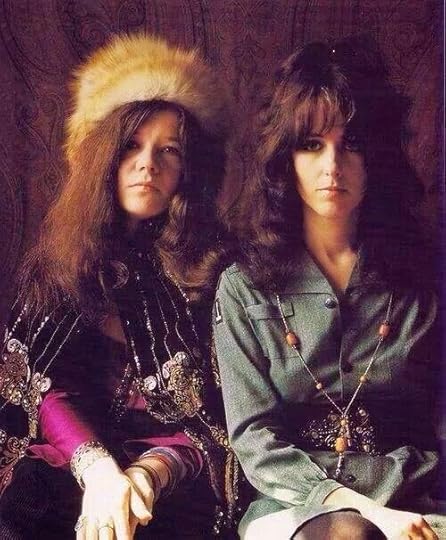 Janis and Grace Slick
Janis and Grace SlickThe list of performers was only outweighed by those who declined or were overlooked: The Beatles, The Beach Boys, Cream, The Kinks and The Doors (who purportedly didn't meet the theme of Music, Love and Flowers).
Monterey was the rock equivalent of a Royal gathering; for fans of rock 'n' roll, there is no other weekend that compares to the events that took place simultaneously in Monterey; not the Beatles at the Hollywood Bowl; not the Doors at the Whiskey; not even big brother Woodstock - Monterey was the jam.
A codicil: While Monterey Pop can be considered the first rock festival, it can clearly be argued that the 1966 Windsor Jazz Blues Festival, despite the name, superceded Monterey by nearly a year. Indeed, Jazz artists by this time in the festival's history were far and in-between. The rock line-up instead was nearly as impressive as Pop: The Small Faces, The Who, The Yardbirds and Cream led the way, with Cream, yet to have the name, and billed as Eric Clapton - Jack Bruce - Ginger Baker.
Published on April 08, 2018 14:13
Story Goes... AOR
It's a term that has seen its day in a world of digital downloads. Album Oriented Rock, or AOR, probably traces its history to Rubber Soul or Pet Sounds, or more difinitively to Dylan's 11 minute opus "Desolation Row" from Highway 61 Revisited, but where it begins matters less than market share. In 1967, LP sales exceeded single sales for the first time in music history. 45s were designed for three minute ditties, radio friendly AM radio tunes that continued the Tin Pan Alley tradition that began with the 78. While The Beatles' "Hey Jude" clocked in at 7:11 and Richard Harris' "McArthur Park" topped out at 7:23, those singles veritably maxed out the quality of the pressing. EPs were usually in the 7 inch format, but were more commonly released at 33 1/3 rpms. As artists ventured into territory that the 45 couldn't accommodate, LPs became more and more popular. Songs like Deep Purple's "Child in Time," or The Doors' "The End" were not even possible in the single format. Instead, songs like "Light My Fire" where truncated to accommodate both a 45 and radio station formats (the LP version is 7:06 long, while the single is 2:52).
This "story" is pretty succinct. Side length tracks like "Close to the Edge," Pink Floyd's "Echoes" or "Supper's Ready" were a product of AOR as well as a product of creativity. Based on iTunes and downloads, AOR is now a historical marker of a more creatively productive era in music. In 1967, AOR was the future.
Published on April 08, 2018 04:17



